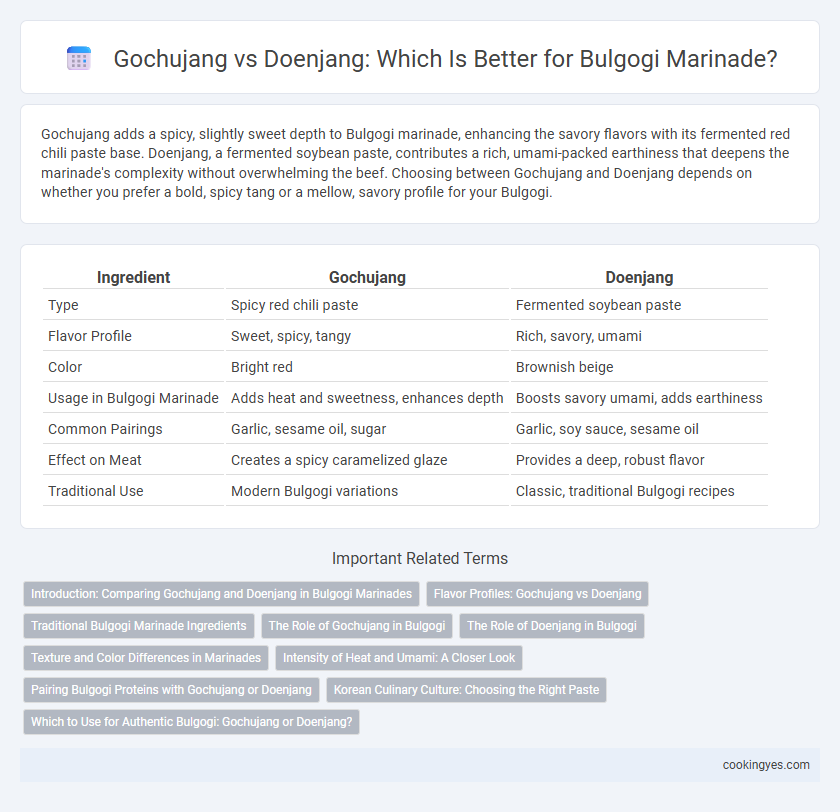Gochujang adds a spicy, slightly sweet depth to Bulgogi marinade, enhancing the savory flavors with its fermented red chili paste base. Doenjang, a fermented soybean paste, contributes a rich, umami-packed earthiness that deepens the marinade's complexity without overwhelming the beef. Choosing between Gochujang and Doenjang depends on whether you prefer a bold, spicy tang or a mellow, savory profile for your Bulgogi.
Table of Comparison
| Ingredient | Gochujang | Doenjang |
|---|---|---|
| Type | Spicy red chili paste | Fermented soybean paste |
| Flavor Profile | Sweet, spicy, tangy | Rich, savory, umami |
| Color | Bright red | Brownish beige |
| Usage in Bulgogi Marinade | Adds heat and sweetness, enhances depth | Boosts savory umami, adds earthiness |
| Common Pairings | Garlic, sesame oil, sugar | Garlic, soy sauce, sesame oil |
| Effect on Meat | Creates a spicy caramelized glaze | Provides a deep, robust flavor |
| Traditional Use | Modern Bulgogi variations | Classic, traditional Bulgogi recipes |
Introduction: Comparing Gochujang and Doenjang in Bulgogi Marinades
Gochujang, a fermented red chili paste, delivers a spicy, slightly sweet flavor that enhances the boldness of Bulgogi marinades, while Doenjang, a fermented soybean paste, provides a deeper umami richness with subtle earthiness. Gochujang-based marinades emphasize heat and vibrant red hues, adding complexity to the grilled meat, whereas Doenjang imparts a mellow, savory aroma, balancing sweetness and saltiness. Both pastes originate from traditional Korean fermentation techniques and contribute unique layers of flavor essential for authentic Bulgogi.
Flavor Profiles: Gochujang vs Doenjang
Gochujang offers a spicy, sweet, and umami-rich flavor that adds depth and a mild heat to Bulgogi, enhancing its savory profile. Doenjang imparts a robust, earthy, and salty taste with fermented soybean notes, creating a more complex and savory marinade. The choice between these Korean condiments significantly influences Bulgogi's flavor profile, balancing sweetness, heat, and umami differently.
Traditional Bulgogi Marinade Ingredients
Traditional Bulgogi marinade primarily features soy sauce, sugar, garlic, sesame oil, and pear juice, emphasizing a sweet and savory profile. Gochujang, a spicy red chili paste, is less common in classic recipes but adds heat and depth when used, whereas Doenjang, a fermented soybean paste, offers a rich umami flavor without spiciness. Authentic Bulgogi marinades balance sweetness and umami, making soy sauce and pear key ingredients, while Gochujang and Doenjang serve more modern or regional variations.
The Role of Gochujang in Bulgogi
Gochujang plays a crucial role in Bulgogi by adding a rich, spicy sweetness that enhances the dish's depth of flavor and provides a vibrant red color. Unlike Doenjang, a fermented soybean paste that imparts umami and earthiness, Gochujang's chili pepper base offers a spicy heat essential for balancing the savory-sweet marinade. Its fermentation process also contributes complex umami notes that elevate the overall taste profile of Bulgogi.
The Role of Doenjang in Bulgogi
Doenjang, a fermented soybean paste, adds a deep umami and earthy flavor to Bulgogi marinade that enhances the meat's savory richness without overpowering its natural sweetness. Unlike the spicy heat from Gochujang, Doenjang contributes complexity and a subtle tang, balancing the marinade with its probiotic qualities and fermented depth. This results in tender, flavorful Bulgogi with a unique depth that highlights traditional Korean fermentation techniques.
Texture and Color Differences in Marinades
Gochujang-based Bulgogi marinade offers a thick, smooth texture with a vibrant red color, enhancing the dish's visual appeal and adding subtle sweetness and spiciness. Doenjang marinade creates a chunkier, grainier texture with a muted brown hue, delivering deep umami flavors and earthiness that complement the meat. The texture and color differences between gochujang and doenjang marinades significantly influence the overall presentation and mouthfeel of Bulgogi.
Intensity of Heat and Umami: A Closer Look
Gochujang offers a bold, spicy heat with a rich, fermented sweetness that intensifies the umami profile of bulgogi marinade, providing a vibrant, complex flavor. Doenjang contributes a deeper, earthy umami with subtle heat, emphasizing savory notes and adding a robust, salty character without overpowering the dish. Choosing between gochujang and doenjang hinges on the desired balance of intense heat versus mellow savoriness in the bulgogi marinade.
Pairing Bulgogi Proteins with Gochujang or Doenjang
Gochujang's spicy-sweet profile enhances beef bulgogi by adding depth and a rich umami layer that complements its tender texture, making it ideal for marinating short ribs or sirloin. Doenjang's savory, fermented soybean flavor pairs better with leaner proteins like chicken or pork, balancing their milder taste with earthy notes that intensify the marinade's complexity. Selecting Gochujang or Doenjang for bulgogi marinades depends on the protein's fat content and texture, optimizing flavor harmony in Korean barbecue dishes.
Korean Culinary Culture: Choosing the Right Paste
Gochujang and Doenjang are essential Korean pastes that shape the flavor profile of Bulgogi marinades, each offering distinct taste experiences. Gochujang, a spicy red chili paste, imparts a rich, sweet heat that enhances Bulgogi with vibrant, bold flavors aligned with Korean culinary preferences for balanced spice and sweetness. Doenjang, a fermented soybean paste, provides a deep umami complexity and earthy notes, reflecting traditional fermentation methods fundamental to Korean gastronomy.
Which to Use for Authentic Bulgogi: Gochujang or Doenjang?
Gochujang enhances bulgogi marinade with its sweet and spicy flavor, imparting a vibrant red color and a hint of heat typical in modern variations. Doenjang, a fermented soybean paste, offers a deeper umami and earthier taste that aligns with traditional recipes capturing the authentic savory profile. For an authentic bulgogi experience, doenjang is preferred, while gochujang suits those seeking a bolder, spicier twist.
Gochujang vs Doenjang for Bulgogi marinade Infographic

 cookingyes.com
cookingyes.com